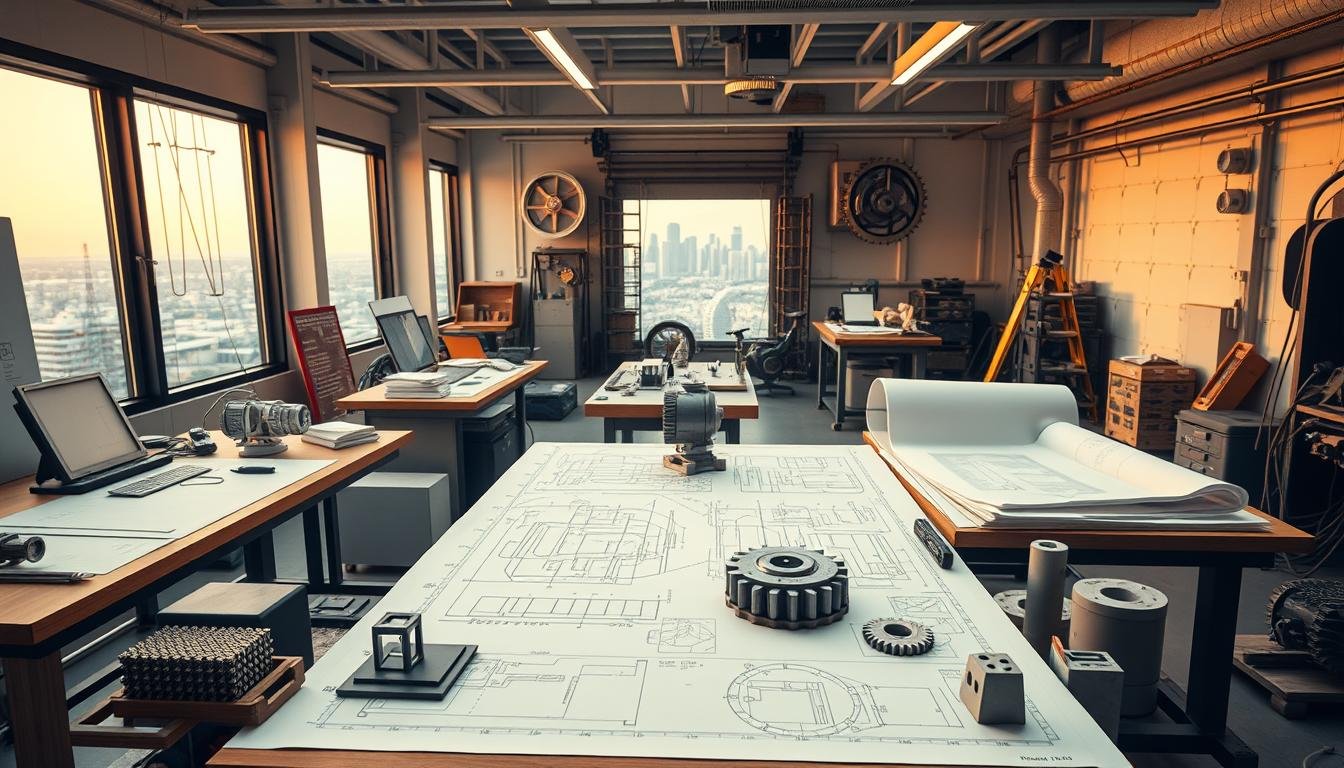I’ve learned how key the principles of engineering design are for success. It’s not just about making things work. It’s also about understanding what users need, if it makes sense financially, and if it looks good. This balance makes sure my designs are both creative and useful, while keeping everyone safe.
Also, good engineering design focuses on making things strong and lasting. If you want to learn more, check out “Engineering Design: A Systematic Approach”. Also, look at case studies from the American Society of Civil Engineers (ASCE) for more insights.
Understanding the Core Principles of Engineering Design:
The core principles of engineering design are key to successful projects. They start with understanding what users need. This involves gathering requirements and talking to stakeholders.
User-centered design makes sure the product meets user expectations. It’s all about creating something that users will love and use.
Safety is a big deal in engineering design. Following codes and regulations ensures structures are safe. This shows respect for users and their surroundings, building trust in engineering.
Sustainable engineering is now a big part of design. Engineers use materials and processes that are good for the environment. This way, they help create a better future for our planet.
Key Elements of Effective Engineering Design:
Effective engineering design relies on several key elements. First, functionality in design is critical. It ensures the product works as intended. Without it, the design can be unsafe and costly to fix.
Design aesthetics also play a big role. A good-looking design can make a complex system easier to use. It boosts user acceptance.
Cost-effective engineering is another must. Engineers need to balance performance, looks, and function while staying within budget. This doesn’t mean cutting corners on quality. It’s about using resources wisely to meet goals efficiently.
Guidance from groups like the American Society of Mechanical Engineers (ASME) is invaluable. They help engineers find the right balance in design.
Engineering Design Process: Steps to Success:
The engineering design process is a series of steps to turn ideas into real solutions. I start with brainstorming and thinking through ideas. This first step lets me explore many options and sketch out plans. It’s important to get this right, as small mistakes can cause big problems later.
Prototyping is a key part of engineering design. Making models or prototypes lets me test ideas in real life. This back-and-forth process helps find and fix problems before we make the final product. It saves time and money, making sure the design works as planned.
Once the prototype is improved, I move on to making the product. This stage involves making the final product on time and within budget. Good project management here is key. It keeps everyone working together smoothly. The engineering design process is about more than just creating something new. It’s about making those ideas real through careful planning and hard work.
Engineering Design Methodologies:
Exploring engineering design methodologies shows us many ways to guide the design process. Traditional methods follow a linear path, with each step building on the last. This makes things clear but can be too rigid for changes or new ideas.
Agile engineering design is more flexible. It uses iterative development to quickly adapt to feedback and changes. This approach encourages teamwork and continuous improvement, making the design process more effective.
Systems engineering is key to making sure all parts of a system work together well. It looks at the big picture, solving problems early on. This way, the whole system works better, thanks to understanding how each part fits together.
User-centered design is all about making products that users love. It focuses on the user’s experience, leading to designs that are easy to use and enjoyable. Getting feedback from real users helps ensure the product meets their needs.
Engineering Design and Innovation:
The field of engineering design is always changing, thanks to new technologies. It’s amazing how these advancements make projects better and faster. One big change is the use of computer-aided design (CAD) software.
This tool makes designs more accurate. It lets engineers create detailed models and test them in simulations. It’s a big step forward.
Looking at cases like the SpaceX Falcon 9 rocket shows how technology changes things. It shows how new tech can make the impossible possible. This cycle of improvement keeps engineers reaching for new heights.
At engineering symposiums and workshops, we see how teams work together. They share ideas and use the latest tech. This teamwork is key to making engineering better and ready for the future.
Best Practices in Engineering Design:
Adopting best practices in engineering design can greatly improve project results. Collaborative design thinking is key. It brings together different views, sparking creativity and innovation. This way, the design process gets stronger and more effective.
Staying committed to continuous improvement is also vital. As technology changes, so should our methods. Regular updates to design processes make us adaptable and efficient.
Keeping detailed records during design is essential. It helps justify decisions and serves as a guide for future projects. Following guidelines from organizations like the Project Management Institute (PMI) helps establish these best practices.
Engineering Design in Real-World Applications:
Engineering design is vital in real-world projects, like building bridges and highways. These structures are key for our daily travel and trade. They must be safe and affordable, thanks to engineering design.
Product design shows how engineering makes our daily items better. Apple, for example, has made electronics both beautiful and useful. This design approach boosts sales and pushes companies to keep improving.
Environmental engineering tackles big issues like climate change. It creates solutions for managing waste, using renewable energy, and cleaning water. This shows how engineering design is essential for a greener future.
